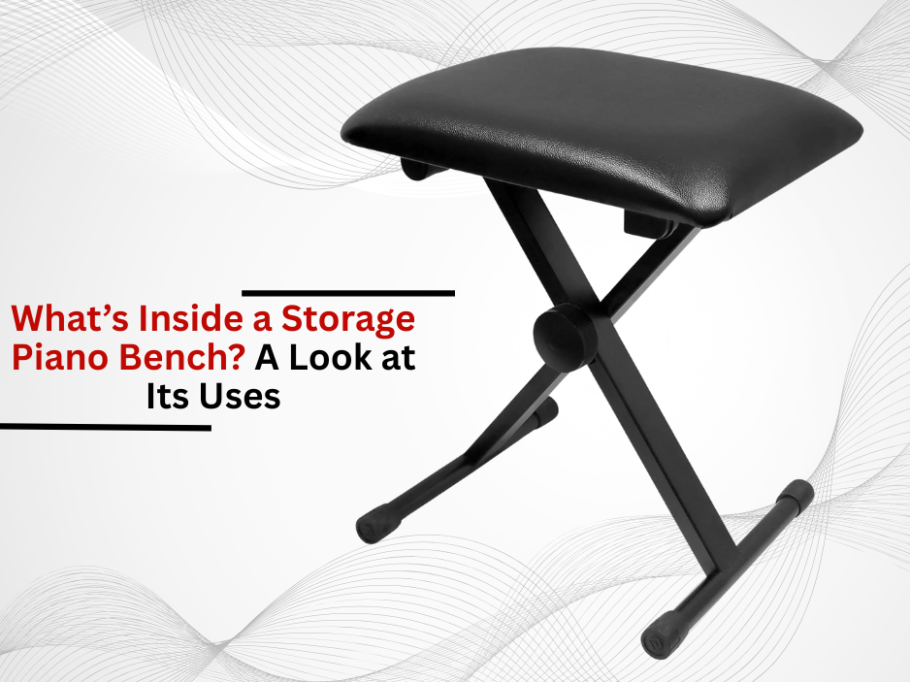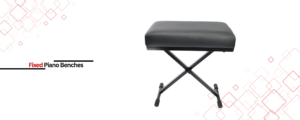Selecting a piano bench does not only concern the appearance; it also affects the comfort, posture, and how the pianist performs their movements. Both portable and fixed benches have unique designs, which provide mobility and ease of movement with fixed integration to aesthetic considerations. The differences in structure, use cases, pacing factors, ongoing considerations, and long-term thinking are discussed below.
To know more, read: Best Piano Benches for Beginners, Intermediate, and Professional Players
Understanding Portable Piano Benches
Design and Mobility Features:
The frame of each portable piano bench is composed of either aluminum or reinforced plastic. Its lightweight construction and foldable design contribute to the creation of portable benches. Their compact shape makes them easy to transport in carrying cases. Portable benches are perfect for educators and gigging musicians. Some models feature mechanisms that allow for adjustable height, but they may lack precision compared to fixed alternatives.
Ideal Use Cases:
These benches are ideal for teaching studios, live performances, and multi-instrumental setups with high storage room environments. Their portability aids musicians with limited storage space. These can be disassembled, stored vertically, or tucked under furniture.
Exploring Fixed Piano Benches
Stability and Ergonomic Design:
Fixed benches come in solid wood, metal, or composite material and eliminate movement on the bench while playing by being fully fixed. Many include adjustable height knobs like threaded bolts to aid alignment with the specially configured spine. Comfort during long practice sessions is improved with padded seats made of memory foam or high-density upholstery.
Enhanced Sitting Endurance:
Non-portable benches sit stationary in ideal locations for easy access. These unmovable benches feature reinforced joints and scratch-resistant finishes, ensuring years of use. Their weight, alongside the bench’s rigid structure, minimizes wear from assembly or disassembly, making them suitable for home studios, conservatories, or permanent installations.
Comparative Analysis—Factors of Interest
Flexibility vs. Sturdiness Mobility:
As it has already been stated, the rigid structures are highly portable and adaptable, which is advantageous. These, however, wobble under vigorous playing due to lighter frames, unlike fixed benches, which provide unwavering stability but lack transportability. They literally anchor users to a single location.
Adjustability vs. Comfort:
Supporting structures such as arm and head rests are highly adjustable on portable benches, while fixed models include advanced ergonomic features such as tilt adjustments or lumbar support. Acute discomfort caused by posture can be remedied with the help of a fixed design intended for posture-related discomfort because it is flexible enough to be accommodating.
Affordability vs. Life Span:
Cheaper fixed benches appear to stay within budget and trim weight, but they tend to be more portable, as they fold and need to be stored, which is a time-consuming exercise. Owing to set hinges and material fatigue, these are replaced sooner than expected. Fixed benches, however, cost more in the beginning, but the price is recovered over decades of dependable use.
Need this in bulk? You can get this from wholesale – piano bench
If you need this at the best prices, you might check out this new platform – piano bench
Aesthetic and Spatial Considerations
Integrating with Surroundings:
Portable and fixed benches are designed in polished walnut and matte black, thus serving both contemporary and traditional spaces. They work well with furnishings and serve as functional, portable models that are often out of place in finely appointed interiors and command utilitarian style.
Space Utilization:
Portable benches are perfect for small apartments or multipurpose rooms, as they can be stored away discreetly. Fixed benches, on the other hand, add to the aesthetic of a professional studio because of the cohesive design but have floor space footprints that are dedicated.
User Scenarios and Recommendations
For Performing Musicians:
Lightweight, height-adjustable, portable benches are recommended for quick transport. Non-slip rubber feet, foldable stools, and quick setup mechanisms streamline the process and save time long-term.
For Domestic Users:
For users who prefer practicing at home, a fixed bench is suggested with adjustable height settings. Optional bear padding enhances comfort without losing structural integrity. Non-structural addenda like sheet music and accessories enhance without rigidity.
For Educational Institutions:
Generally movable or portable options for rehearsal rooms with adjustable seating arrangements are tertiary. It is the case that students are made to use hard, fixed benches.
Conclusion
Ultimately, the decision of whether to go for a portable or a fixed piano bench is determined by subjective factors like convenience of transport versus being anchored in one place or cost versus enduring quality. Brands such as 5 Core, Roland and On Stage make chairs to suit both ends of the spectrum, so no musician is left without a design that meets his or her needs. Looking at the objectives and goals, whether they are a professional performer or a hobbyist, they will most likely find a bench that best fits their needs at any point along their musical journey.




